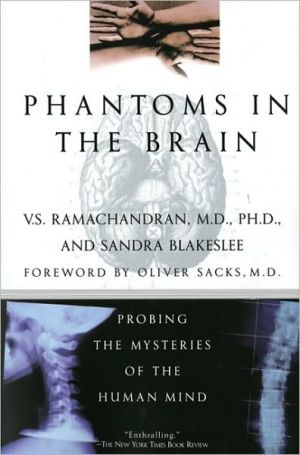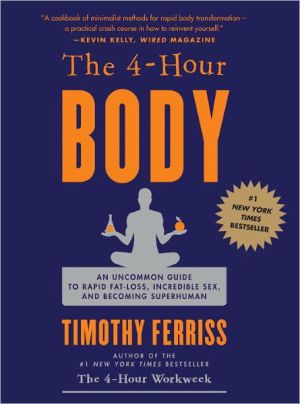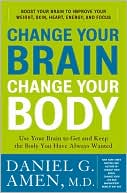Phantoms in the Brain: Probing the Mysteries of the Human Mind
Neuroscientist V.S. Ramachandran is internationally renowned for uncovering answers to the deep and quirky questions of human nature that few scientists have dared to address. His bold insights about the brain are matched only by the stunning simplicity of his experiments — using such low-tech tools as cotton swabs, glasses of water and dime-store mirrors. In Phantoms in the Brain, Dr. Ramachandran recounts how his work with patients who have bizarre neurological disorders has shed new light...
Search in google:
Neuroscientist V.S. Ramachandran is internationally renowned for uncovering answers to the deep and quirky questions of human nature that few scientists have dared to address. His bold insights about the brain are matched only by the stunning simplicity of his experiments -- using such low-tech tools as cotton swabs, glasses of water and dime-store mirrors. In Phantoms in the Brain, Dr. Ramachandran recounts how his work with patients who have bizarre neurological disorders has shed new light on the deep architecture of the brain, and what these findings tell us about who we are, how we construct our body image, why we laugh or become depressed, why we may believe in God, how we make decisions, deceive ourselves and dream, perhaps even why we're so clever at philosophy, music and art. Some of his most notable cases: * A woman paralyzed on the left side of her body who believes she is lifting a tray of drinks with both hands offers a unique opportunity to test Freud's theory of denial. * A woman who hallucinates cartoon characters illustrates how, in a sense, we are all hallucinating, all the time. Dr. Ramachandran's inspired medical detective work pushes the boundaries of medicine's last great frontier -- the human mind -- yielding new and provocative insights into the "big questions" about consciousness and the self. The New York Times "Enthralling . . . eloquent."
The Phantom Within\ A man wearing an enormous bejeweled cross dangling on a gold chain sits in my office, telling me about his conversations with God, the "real meaning" of the cosmos and the deeper truth behind all surface appearances. The universe is suffused with spiritual messages, he says, if you just allow yourself to tune in. I glance at his medical chart, noting that he has suffered from temporal lobe epilepsy since early adolescence, and that is when "God began talking" to him. Do his religious experiences have anything to do with his temporal lobe seizures?\ An amateur athlete lost his arm in a motorcycle accident but continues to feel a "phantom arm" with vivid sensations of movement. He can wave the missing arm in midair, "touch" things and even reach out and "grab" a coffee cup. If I pull the cup away from him suddenly, be yelps in pain. "Ouch! I can feel it being wrenched from my fingers," he says, wincing.\ A nurse developed a large blind spot in her field of vision, which is troubling enough. But to her dismay, she often sees cartoon characters cavorting within the blind spot itself. When she looks at me seated across from tier, she sees Bugs Bunny in my lap, or Elmer Fudd, or the Road Runner—Or sometimes she sees cartoon versions of real people she's always known.\ A schoolteacher suffered a stroke that paralyzed the left side of her body, but she insists that her left arm is not paralyzed. Once, when I asked her whose arm was lying in the bed next to her, she explained that the limb belonged to her brother.\ A librarian from Philadelphia who had a different kind of full day, until she literally died laughing.\ Andthen there is Authur, a young man who sustained a terrible head injury in an automobile crash and soon afterward claimed that his father and mother had been replaced by duplicates who looked exactly like his real parents. He recognized their faces but they seemed odd, unfamiliar. The only war Arthur could make any sense out of the situation was to assume that his parents were impostors.\ None of these people is "crazy"; sending them to psychiatrists would be a waste of time. Rather, each of them suffers from damage to a specific part of the brain that leads to bizarre but highly characteristic changes in behavior. They hear voices, feel missing limbs, see things that no one else does, deny the obvious and make wild, extraordinary claims about other people and the world we all live in. Yet for the most part they are lucid, rational and no more insane than you or I.\ Although enigmatic disorders like these have intrigued and perplexed physicians throughout history, they are usually chalked up as curiosities—case studies stuffed into a drawer labeled "file and forget." Most neurologists who treat such patients are not particularly interested in explaining these odd behaviors. Their goal is to alleviate symptoms and to make people well again, not necessarily to dig deeper or to learn how the brain works. Psychiatrists often invent ad hoc theories for curious syndromes, as if a bizarre condition requires an equally bizarre explanation. Odd symptoms are blamed on the patient's upbringing (bad thoughts from childhood) or even on the patient's mother (a bad nurturer). Phantoms in the Brain take the opposite viewpoint. These patients, whose stories you will hear in detail, are our guides into the inner workings of the human brain-yours and mine. Far from being curiosities, these syndromes illustrate fundamental principles of how the normal human mind and brain work, shedding light on the nature of body image, language, laughter, dreams, depression and other hallmarks of human nature. Have you ever wondered why some jokes are funny and others are not, why you make an explosive sound when you laugh, why you are inclined to believe or disbelieve in God, and why you feel erotic sensations when someone sticks your toes? Surprisingly, we can now begin to provide scientific answers to at least some of these questions. Indeed, by studying these patients, we can even address lofty "philosophical" questions about the nature of the self: Why do you endure as one person through space and time, and what brings about the-seamless unity of subjective experience? What does it mean to make a choice or to will an action? And more generally, how does the activity of tiny wisps of protoplasm in the brain lead to conscious experience?\ Philosophers love to debate questions like these, but it's only now becoming clear that such issues can be tackled experimentally. By moving these patients out of the clinic and into the laboratory, we can conduct experiments that help reveal the deep architecture of our brains. Indeed, we can pick up where Freud left oft ushering in what might be called an era of experimental epistemology (the study of how the brain represents knowledge and belief) and cognitive neuropsychiatry (the interface between mental and physical disorders of the brain), and start experimenting on belief systems, consciousness, mind-body interactions and other hallmarks of human behavior.\ I believe that being a medical scientist is nor all that different from being a sleuth. In this book, I've attempted to share the sense of mystery that lies at the heart of all scientific pursuits and is especially characteristic of the forays we make in trying to understand our own minds. Each story begins with either an account of a patient displaying seemingly inexplicable symptoms or a broad question about human nature, such as why we laugh or why we are so prone to self-deception. We then go step by step through the same sequence of ideas that I followed in my own mind as I tried to tackle these cases. In some instances, as with phantom limbs, I can claim to have genuinely solved the mystery. In others-as in the chapter on God-the final answer remains elusive, even though we come tantalizingly close. But whether the case is solved or not, I hope to convey the spirit of intellectual adventure that accompanies this pursuit and makes neurology the most fascinating of all disciplines. As Sherlock Holmes told Watson, "The game is afoot!"
ForewordPrefaceCh. 1The Phantom Within1Ch. 2"Knowing Where to Scratch"21Ch. 3Chasing the Phantom39Ch. 4The Zombie in the Brain63Ch. 5The Secret Life of James Thurber85Ch. 6Through the Looking Glass113Ch. 7The Sound of One Hand Clapping127Ch. 8"The Unbearable Likeness of Being"158Ch. 9God and the Limbic System174Ch. 10The Woman Who Died Laughing199Ch. 11"You Forgot to Deliver the Twin"212Ch. 12Do Martians See Red?227Acknowledgments259Notes263Bibliography and Suggested Reading299Index314
\ Francis CrickThis is a splendid book.\ \ \ \ \ Francis Crick"This is a splendid book."\ \ \ Michael E. GoldbergThe book is enthralling not only for its clear, eloquent description of neurological phenomena...but also for its portrait of Ramachandran, the enthusiast in search of the secrets of the human mind. Phantoms in the Brain is about both...and he is a splendid subject indeed.\ — The New York Times Book Review\ \ \ \ \ New York Times Book ReviewEnthralling . . . eloquent.\ \ \ \ \ The New York Times"Enthralling . . . eloquent."\ \ \ \ \ Publishers WeeklyIn these unsettling tales from a neuroscientist every bit as quirky as the more well-known Oliver Sacks, Ramachandran sets out his beliefs that no matter how bizarre the case, empirical, strikingly simple testing can illuminate the ways brain circuitry establishes "self." In a chatty, nearly avuncular style, he (along with his coauthor, a New York Times science writer) snatches territory from philosophers on how we think we know what we know. In one experiment, stroking an amputee's cheek produces sensations in his "phantom limb" because the part of the brain's map that once related to the lost limb has "invaded" the adjacent brain area that relates to the cheek. Unafraid to speculate, Ramachandran then moves a step closer toward indicating that the brain is not only a busy lump of genetically deemed-and-dying hard-wiring but an organ that can continuously "re-map" in response to new sensory information from the outside. Equally fascinating are Ramachandran's "mirror tricks" on amputees and paralyzed patients that begin to reveal how much the brain relies on context and comparison as well as on "inside" neural connectivity to form self. Perhaps most disquieting are beginnings of proof that much brain activity, including what we like to think of as uniquely human behavior, happens unbidden. There may be no escape from the un-Western conclusion that self is only a limited illusion. "De-throning man," as the author points out, is at the heart of most revolutionary scientific thought. Regrettably, his book sags in the middle as it drifts from these deft experiments into generalized musings on idiot-savants and phantom pregnancies, detracting from what is otherwise entertaining, tip-of-the-neurological-iceberg sleuthing.\ \ \ \ \ Library JournalNeuroscientist Ramachandran looks at neurological disorders to help us understand brain function.\ \ \ \ \ Michael E. GoldbergThe book is enthralling not only for its clear, eloquent description of neurological phenomena...but also for its portrait of Ramachandran, the enthusiast in search of the secrets of the human mind. Phantoms in the Brain is about both...and he is a splendid subject indeed. -- The New York Times Book Review\ \ \ \ \ Kirkus ReviewsInsights and intriguing speculations from a neurologist whose patients provide him with unusual opportunities to explore the brain. Ramachandran's present volume began as a "Decade of the Brain" lecture given three years ago at the annual meeting of the Society for Neuroscience. With the help of New York Times writer Blakeslee, he has expanded that address to scientists into a work of popular science for the general reader. He introduces patients with strange, sometimes extraordinary, symptomsþa man who experiences orgasms in an amputated, or phantom, foot; a woman who is convinced that her own arm must belong to her brother; stroke victims who insist they can move their paralyzed limbs; an accident survivor who believes that his parents are imposters; perfectly sane men and women with hallucinations of animals, objects, even cartoons—and then offers his ideas about what is going on in the patient's brain that would explain such symptoms. Often he devises ingenious experiments involving mirrors, gloves, and helpful graduate students to test his ideas. The results are a new understanding of how information from different senses interacts and how the brain forms new connections and updates its model of reality in response to new sensory inputs. The wide-ranging Ramachandran also looks into the brain for clues about the mystery of autistic savants, human laughter, multiple personality disorder, religious experiences, and the very nature of the self. Besides informative drawings and images of the human brain, the text contains numerous illustrations demonstrating optical phenomena that demand reader involvement. Ramachandran, who likens himself to a sleuth and hasboundless curiosity, leads readers on a riveting trail of detection. \ \








